Top Constant Contact Alternatives in 2025
Written by: Hrishikesh Pardeshi, Founder at Flexiple, buildd & Remote Tools.
Last updated: Mar 10, 2025
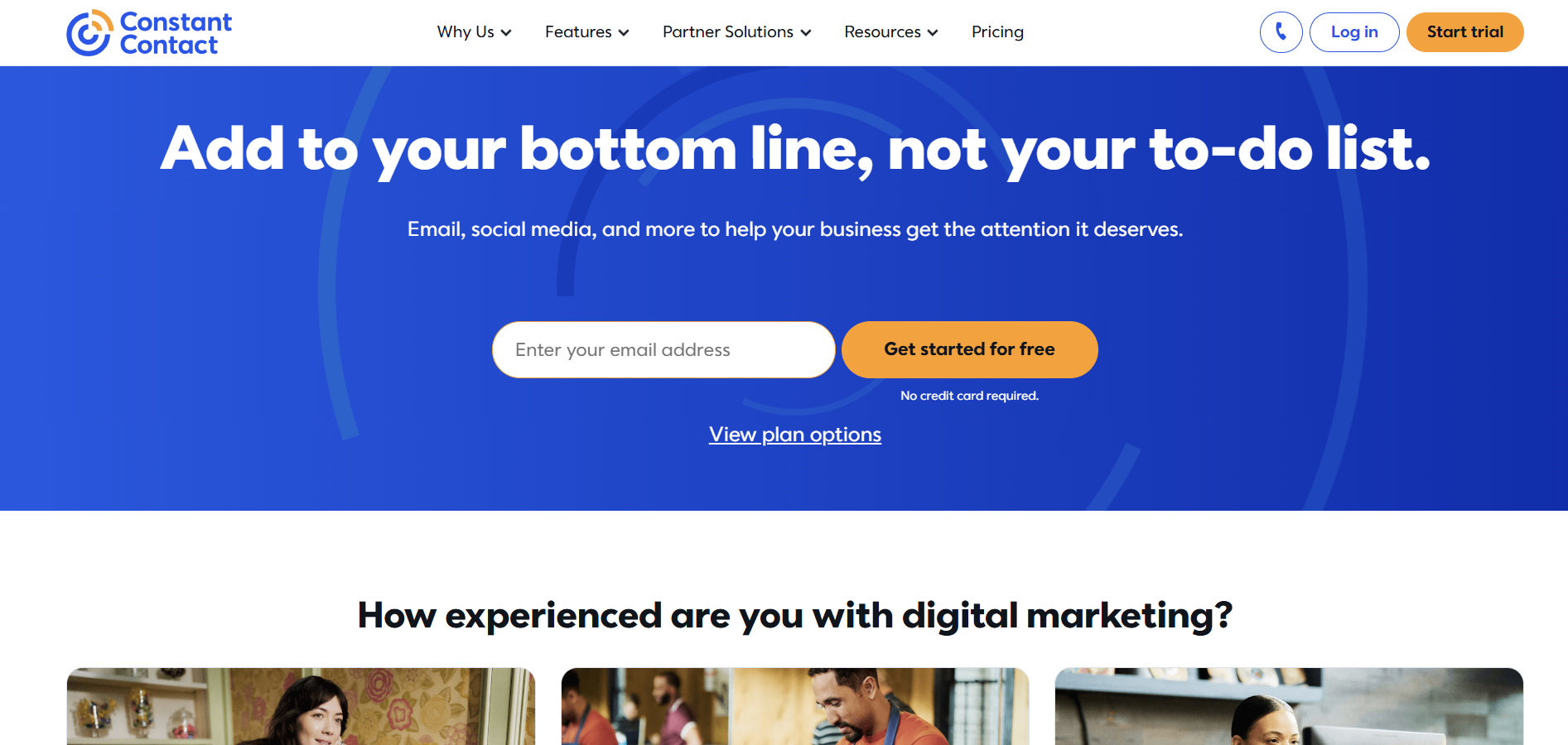
The best Constant Contact alternatives in 2025 for email marketing and automation are Mailchimp, AWeber, GetResponse, Sendinblue, ActiveCampaign, and Klaviyo. These six platforms excel in different areas of digital marketing, offering features that range from beginner-friendly templates and intuitive workflow builders to advanced automation sequences and robust e-commerce integrations. By exploring these tools, you can find a more tailored approach to running email campaigns, nurturing leads, and maintaining customer relationships than what Constant Contact alone might deliver.
Email marketing remains a cornerstone of any well-rounded marketing strategy. Despite the rise of social media and SMS marketing, email consistently offers strong return on investment, direct communication with prospects, and a reliable way to share both promotional and informational content. Constant Contact has served many organizations well over the years, particularly those looking for a straightforward solution with basic automation features. However, as businesses evolve, they often require features that go beyond a single platform’s scope—advanced segmentation, deeper analytics, or specialized e-commerce automations. In this guide, we take a detailed look at why you might need an affordable Constant Contact alternative, who can benefit most, and how each alternative provides unique advantages to help your email marketing efforts flourish well into 2025. We focus on the best Constant Contact competitors, known for their intuitive interfaces and robust support options like phone support, to ensure you have all the tools necessary for success.
Table of Contents
Why Do You Need Alternatives to Constant Contact?
Every email marketing service has its strengths, but no single solution can address every organization’s nuanced requirements. Here are some common reasons you might need to explore alternatives to Constant Contact:
-
Deeper Automation and Segmentation
Complex Triggered Campaigns: Many marketers seek to establish intricate workflows that respond to subscriber behavior. If a user watches a product demo, for example, you may want to trigger a custom follow-up that delivers relevant case studies. Constant Contact’s automation has improved, but more advanced platforms like ActiveCampaign or GetResponse can handle conditional logic, advanced lead scoring, and multi-step sequences with greater finesse.
Dynamic Content Personalization: Modern email campaigns often rely on pulling in real-time data about users, from items in their online shopping cart to pages viewed on a website. Certain Constant Contact alternatives allow you to insert dynamic blocks that reflect each subscriber’s specific interests, showing them content or offers tailored to their behavior.
-
Enhanced Analytics and Reporting
Granular Tracking: While Constant Contact provides a basic dashboard of open rates, click-through rates, and bounces, you may crave more detail. Some alternatives offer heatmap tracking within emails, enabling you to see which parts of your message attract the most attention. Others allow you to track conversions more precisely by tying your campaigns to specific sales or sign-ups.
Advanced A/B or Multivariate Testing: For businesses scaling rapidly, incremental improvements in open or click rates can significantly impact revenue. Platforms like Mailchimp, GetResponse, or ActiveCampaign often support robust testing frameworks, enabling you to experiment with subject lines, design elements, timing, or even entire funnel sequences.
-
Multi-Channel Engagement
Beyond Emails: Today’s marketing can involve layered communication tactics—email is crucial, but so are SMS notifications, chatbots, and social media re-targeting. Tools like Sendinblue or ActiveCampaign facilitate more holistic approaches. By adopting an all-in-one strategy, you can maintain a consistent message across multiple touchpoints, improving brand recognition and driving conversions from various channels.
Transaction Emails in One Place: If you’re running an online store, you might also want to unify your promotional newsletters with transactional emails such as purchase receipts, shipping updates, and password resets. A platform that manages both marketing and transactional emails can simplify your workflow, ensuring consistent branding.
-
Scalable Pricing and Feature Sets
Free Tiers for Testing: Small businesses or startups might want to test the waters before committing to a larger monthly expense. Some alternatives offer robust free plans that let you explore advanced automation or large contact storage. Mailchimp and Sendinblue, in particular, are known for their generous free tiers.
Pay-by-Email vs. Pay-by-Contact: Constant Contact typically charges based on the number of contacts in your list. If you have a large list but send fewer campaigns, a provider like Sendinblue—where you pay by email volume rather than contacts—could save you money. Conversely, if you have frequent sends, you might consider a contact-based plan.
-
E-commerce-Driven Features
Revenue and Conversion Tracking: For e-commerce merchants, the ability to measure ROI directly from email campaigns is essential. Platforms like Klaviyo integrate deeply with your store, giving you real-time stats on how many sales an email generated. If Constant Contact doesn’t offer enough detail, an alternative could fill that gap.
Advanced Cart Abandonment and Product Recommendations: While some basic cart abandonment automations exist in Constant Contact, you may want more robust or flexible triggers, or the ability to integrate product recommendations. Klaviyo and ActiveCampaign have sophisticated e-commerce modules, letting you tailor marketing sequences based on browsing or purchase behavior.
-
Platform Synergy and Integrations
Customized Tech Stacks: You might already rely on a specific CRM, analytics tool, or web-building platform that needs to sync seamlessly with your email marketing system. If Constant Contact’s integrations are lacking or simplistic, you’ll find that many competitors boast extensive app ecosystems or open APIs, enabling deeper custom connections.
By understanding these potential gaps, you can better determine what alternative service might elevate your campaigns. Instead of contorting your strategy to fit a single platform, you can choose a tool that naturally supports your business objectives.
Who Should Consider Using Constant Contact Alternatives?
Not everyone needs to move away from Constant Contact. It remains a strong option for certain smaller or less complex marketing situations. However, there are distinct categories of organizations and professionals who might see notable benefits by switching.
1. Small Businesses Looking for Cost-Effective Solutions
New Entrepreneurs with Limited Budgets: If you’re in your early stages, cost control is often a top priority. Alternatives like Mailchimp or AWeber can be more affordable, especially given free plans or lower entry tiers that still include features like automation or easy-to-use templates.
Local Brick-and-Mortar Shops: Physical stores expanding into online marketing may want a simple, straightforward platform that grows with them. Some alternatives offer a pay-as-you-go model, which might be more flexible for local businesses running occasional campaigns.
2. Marketers Focused on Advanced Automation and Analytics
Inbound Marketing Agencies: Agencies often manage multiple client accounts, requiring in-depth reporting and the ability to set up specialized workflows that are triggered by user activity. Tools like ActiveCampaign or GetResponse excel in advanced automation.
Content Creators: Bloggers, podcasters, or educators using drip sequences and segmented lists for exclusive content can exploit robust platforms that highlight user engagement in detail, tracking which segments respond best to certain offerings or topics.
3. E-commerce and Retail Brands
Online Store Owners: If you run a Shopify, WooCommerce, or Magento store, you might need deeper synergy between your email campaigns and your product listings. Some alternatives directly integrate with your store to track real-time sales data, facilitate triggered messages (like “complete your purchase” after cart abandonment), and even display recommended products within emails.
Subscription Box Services: Sub-based businesses rely heavily on recurring revenue. Platforms specialized in e-commerce can help reduce churn via automated discount offers for re-subscription, alerts for impending renewals, or personalized “thank you” sequences after each renewal event.
4. Enterprises Seeking Multi-Channel Outreach
Large-Scale Operations: Enterprises often need advanced segmentation and the capacity to handle multiple brand lines or a vast array of contact data. An alternative to Constant Contact could provide better user management, comprehensive analytics, and the ability to do multi-channel remarketing or retargeting.
Non-Profits with Complex Donor Relations: Even beyond commerce, large non-profits often manage large donor lists, volunteers, and recurring donors. Comprehensive segmentation, dynamic fields, and multi-channel reminders can greatly improve engagement and donations.
In every case, the key is aligning your email marketing tool with the complexity of your campaigns, your growth trajectory, and the channels you want to leverage. Constant Contact might still be enough for some organizations, but if you fall into one of the groups above and sense that your campaigns are hitting a plateau, these alternatives can open new possibilities for personalization, automation, and integrated marketing success.
Comparison Table of Constant Contact Alternatives
| Feature | Mailchimp | AWeber | GetResponse | Sendinblue | ActiveCampaign | Klaviyo |
|---|---|---|---|---|---|---|
| Ease of Use | Easy | Moderate | Easy | Easy | Moderate | Moderate |
| Pricing | Free & Paid Plans | Paid | Free & Paid Plans | Free & Paid Plans | Paid | Free & Paid Plans |
| Platform Support | Browser-based | Browser-based | Browser-based | Browser-based | Browser-based | Browser-based |
| Collaboration Features | Moderate | Moderate | Moderate | Moderate | Extensive | Extensive |
| Special Features | Automation & Segmentation | Email Marketing & Automation | All-in-One Marketing | SMS & Email Marketing | CRM & Email Automation | E-commerce Focused |
Best Constant Contact Alternatives
Below is an in-depth look at six of the top alternatives to Constant Contact, each offering distinct advantages that cater to varying marketing goals. These sections delve into how each platform stacks up against its Constant Contact competitors, their core strengths, any potential drawbacks, and how each platform’s pricing model works. By analyzing these details, you can identify the solution best suited to your current and future marketing needs.
1. Mailchimp
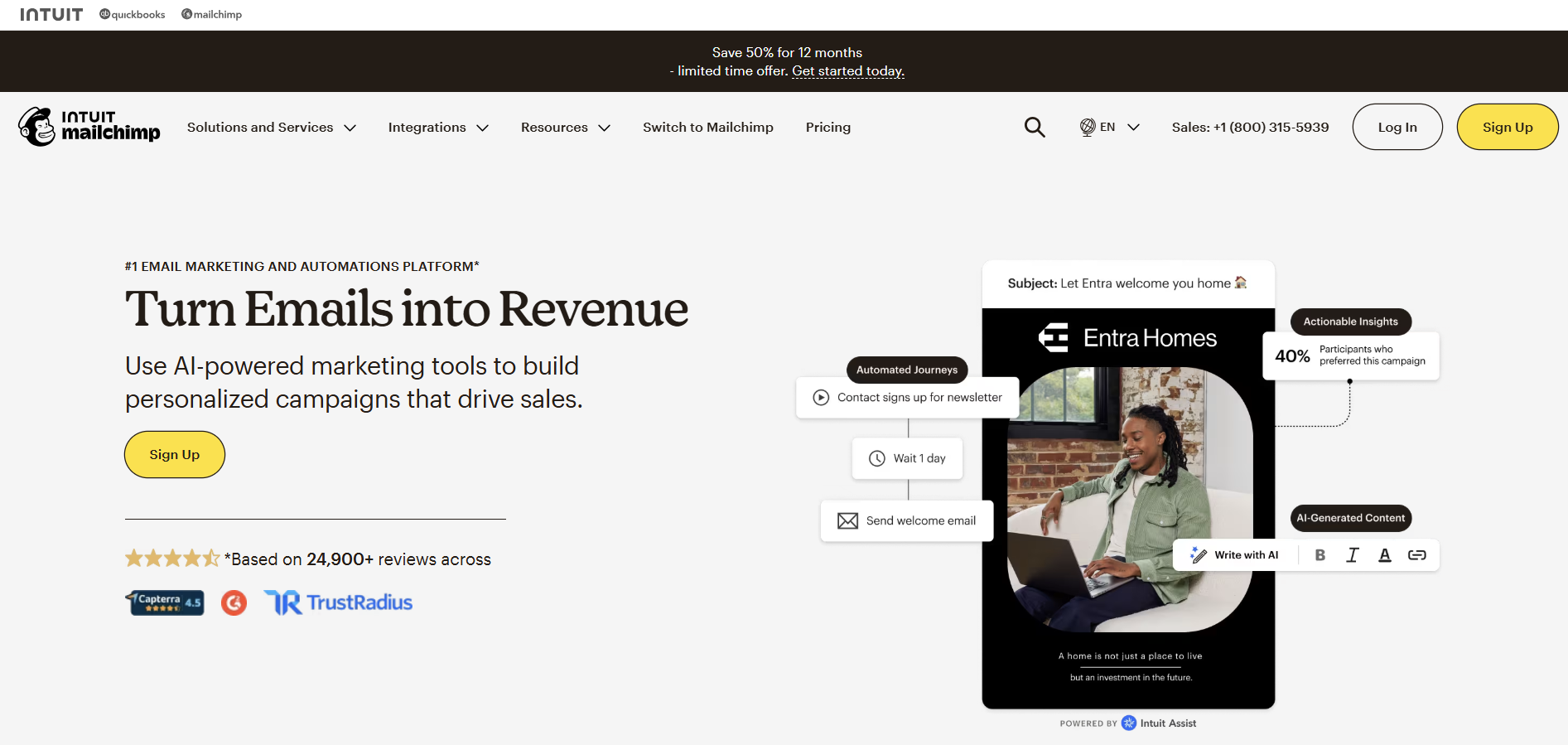
Mailchimp is practically synonymous with email marketing for many small businesses. Created to be accessible and quick to launch, it delivers robust automation, pre-designed templates, and straightforward campaign management. Over time, Mailchimp has also built out advanced segmentation capabilities and integrated e-commerce features to keep pace with the evolving email marketing landscape.
Mailchimp vs Constant Contact
Greater Template Variety: Constant Contact has its own range of templates, but Mailchimp’s library often includes more modern, aesthetically pleasing options.
A/B Testing Depth: Where Constant Contact may offer basic split testing, Mailchimp can support multivariate tests for subject lines, email body variations, or calls-to-action.
Scalable Free Plan: While Constant Contact doesn’t currently maintain a similar free plan, Mailchimp provides a no-cost option for small subscriber counts, giving users a low-risk way to experiment.
Key Features of Mailchimp
Drag-and-Drop Editor: Perfect for beginners, letting you craft professional-looking emails in minutes.
Powerful Integrations: Sync with CRMs, e-commerce apps, social media, and more, helping unify your marketing efforts.
Behavior-Based Workflows: Trigger automated campaigns when users visit a page, buy a product, or subscribe to a certain list.
Predictive Insights: Over time, Mailchimp can analyze performance data to recommend sending times or subject lines that yield higher engagement.
Mailchimp Pros
Beginner-Friendly: Marketers new to email can start quickly, using step-by-step guides and tooltips.
Regular Feature Updates: The platform invests heavily in staying current, rolling out new analytics and design tools.
Community and Support: With a large user community, you’ll often find solutions, tutorials, and third-party tools that integrate directly with Mailchimp’s API.
Mailchimp Cons
Pricing Escalation: As your list grows or you add advanced features (like retargeting or advanced segmentation), costs can climb quickly.
Limited Support for Free Users: Email-only assistance for free tiers can slow down troubleshooting if you have urgent issues.
May Lack Certain High-End Automations: Though robust, Mailchimp’s automation is not as flexible as ActiveCampaign’s if you need extremely nuanced branching logic.
Mailchimp Pricing
Mailchimp’s free option supports up to 500 contacts, with limited sends per month. Paid plans begin at modest monthly fees but scale depending on contact volume and advanced feature usage—like multivariate testing, advanced audience segmentation, or brand kits.
2. AWeber
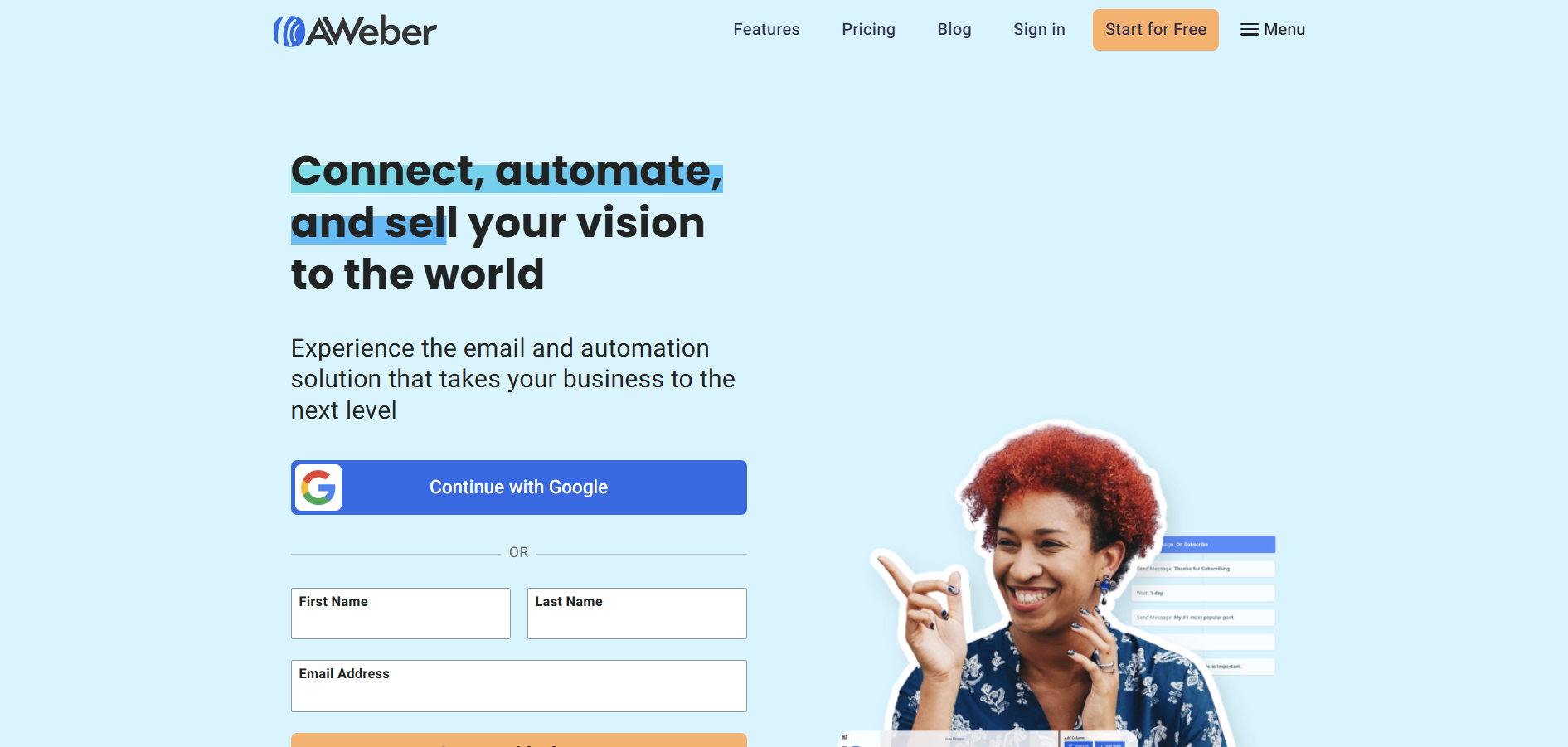
AWeber is best known for its user-friendly approach to email marketing, focusing on core functionalities like broadcast emails, autoresponder sequences, and reliable deliverability. It has a longstanding reputation for good customer service and a minimal learning curve.
AWeber vs Constant Contact
Simplicity for Beginners: AWeber’s design interface is streamlined, making it a contender for those who find Constant Contact somewhat cluttered or who prefer an even easier campaign-building experience.
Emphasis on Deliverability: For marketers who frequently worry about spam folder landings, AWeber is known for measures that improve open rates.
Key Features of AWeber
Autoresponder Workflows: Create timed sequences for new subscribers, customers who made a purchase, or those who showed interest in a specific topic.
Drag-and-Drop Templates: Dozens of themes that adapt to mobile screens, ensuring consistent brand presentation.
Sign-Up Form Builder: AWeber helps embed sign-up forms on your website, capturing leads without extra plugins.
List Segmentation: While not as advanced as ActiveCampaign or Klaviyo, it provides enough filters for basic segmentation based on subscriber activity.
AWeber Pros
Transparent Pricing: No hidden fees for additional functionality. You pay more primarily when your subscriber list grows.
Customer Support: Renowned for phone, chat, and email support that quickly resolves issues, which can be critical if you need immediate help.
Reliability: The platform’s stable infrastructure means fewer outages and consistent sending speeds.
AWeber Cons
Lower-Level Automations: If you envision extremely sophisticated sequences, AWeber may not measure up to advanced platforms.
Older-School Interface: Though frequently updated, some aspects may appear less modern in design or UI compared to flashier competitors.
Limited Cross-Channel Features: Focus remains on email; you won’t see integrated SMS, chat, or e-commerce functionalities at the same scale as other tools.
AWeber Pricing
AWeber’s pricing is predominantly subscriber-based, where you start at a certain monthly fee for a set number of contacts and move to higher tiers as your list expands. This model suits small and medium-sized businesses with a predictable growth trajectory.
3. GetResponse
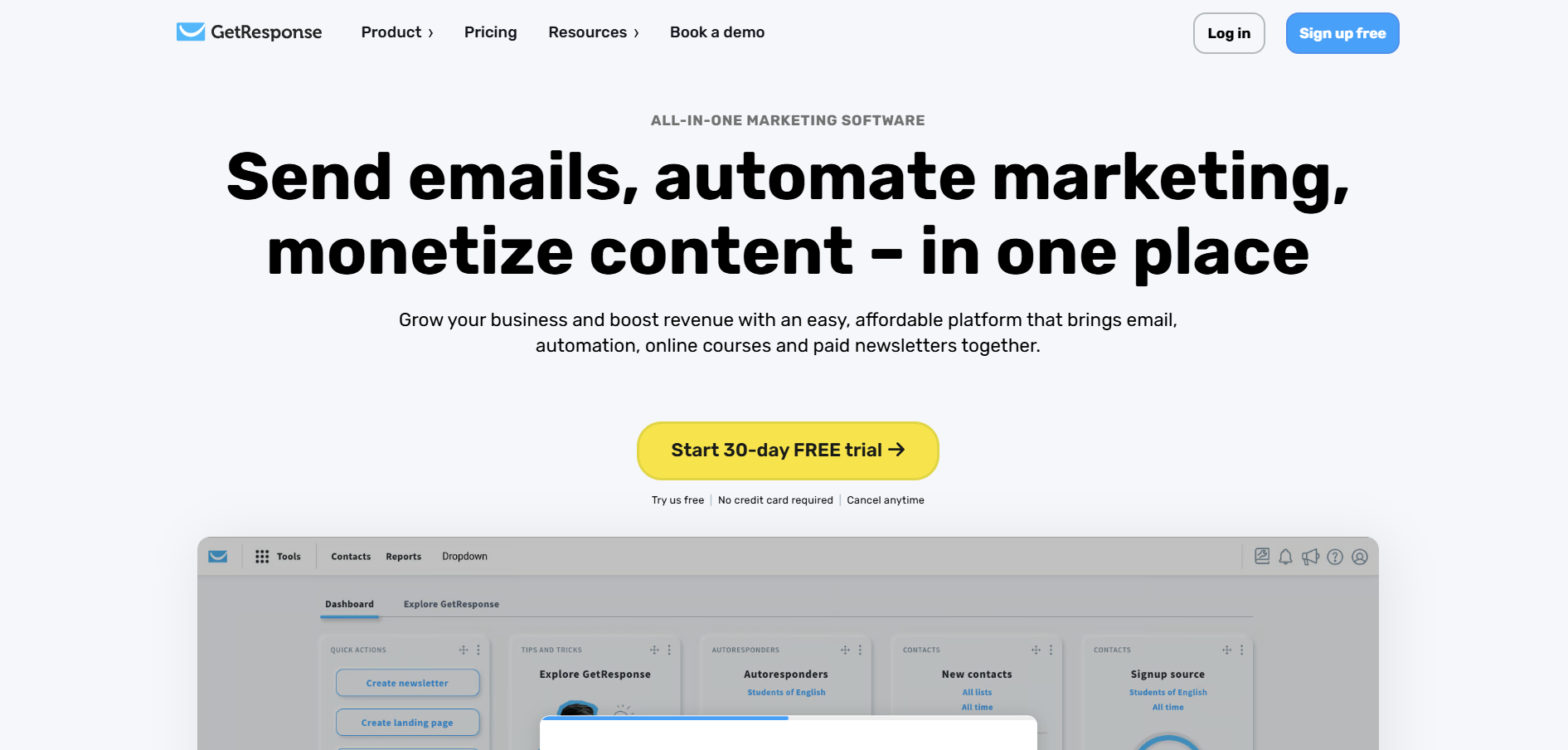
GetResponse styles itself as an all-encompassing marketing platform that goes well beyond email. It offers a landing page builder, pages, webinars, CRM, and marketing automation. This suite-based approach can be highly appealing if you want fewer tools in your tech stack.
GetResponse vs Constant Contact
All-in-One Tools: Constant Contact has tried to expand beyond email but remains predominantly an email solution. GetResponse provides funnel creation, CRM, webinar hosting, and robust automation for a cohesive marketing machine.
Automation Builder: While Constant Contact does supply triggered emails, GetResponse’s workflow builder is more visual and powerful, allowing complex branching and nested conditions.
Key Features of GetResponse
Landing Page Creation: Build pages for lead magnets, event registrations, or product promos, saving you from using separate tools.
Webinar Hosting: Convert your audience with live or recorded webinars, track engagement, and push follow-up campaigns automatically.
CRM Functionality: Manage deals and pipeline statuses inside GetResponse without needing an external CRM.
Scalable Automation: The visual builder is easy to learn yet can orchestrate quite complex marketing funnels.
GetResponse Pros
Holistic Marketing Approach: Instead of juggling multiple logins and integrations, you can manage various aspects of marketing in one place.
Easy-to-Use Funnel Builder: Users can create multi-step funnels that incorporate landing pages, email follow-ups, and product sales.
Perfect for Webinars: If your brand relies on digital events, you can integrate sign-up forms, email reminders, and post-webinar thank-you sequences seamlessly.
GetResponse Cons
Overwhelming for Some: If you only need basic email marketing, the broad features might feel like overkill.
Higher Tiers Needed for Advanced Tools: The essential plan covers emails and basic automation, but you’ll need pricier plans for the webinar tool or advanced CRMs.
Learning Curve: Mastering the entire suite (pages, webinars, advanced segmentation) demands time and possibly staff training.
GetResponse Pricing
GetResponse bases pricing on subscriber count and the features you desire. Smaller lists can start on a Basic plan with access to core features, while advanced tiers open up more advanced reporting, robust funnel and CRM options, along with the webinar functionality.
4. Sendinblue
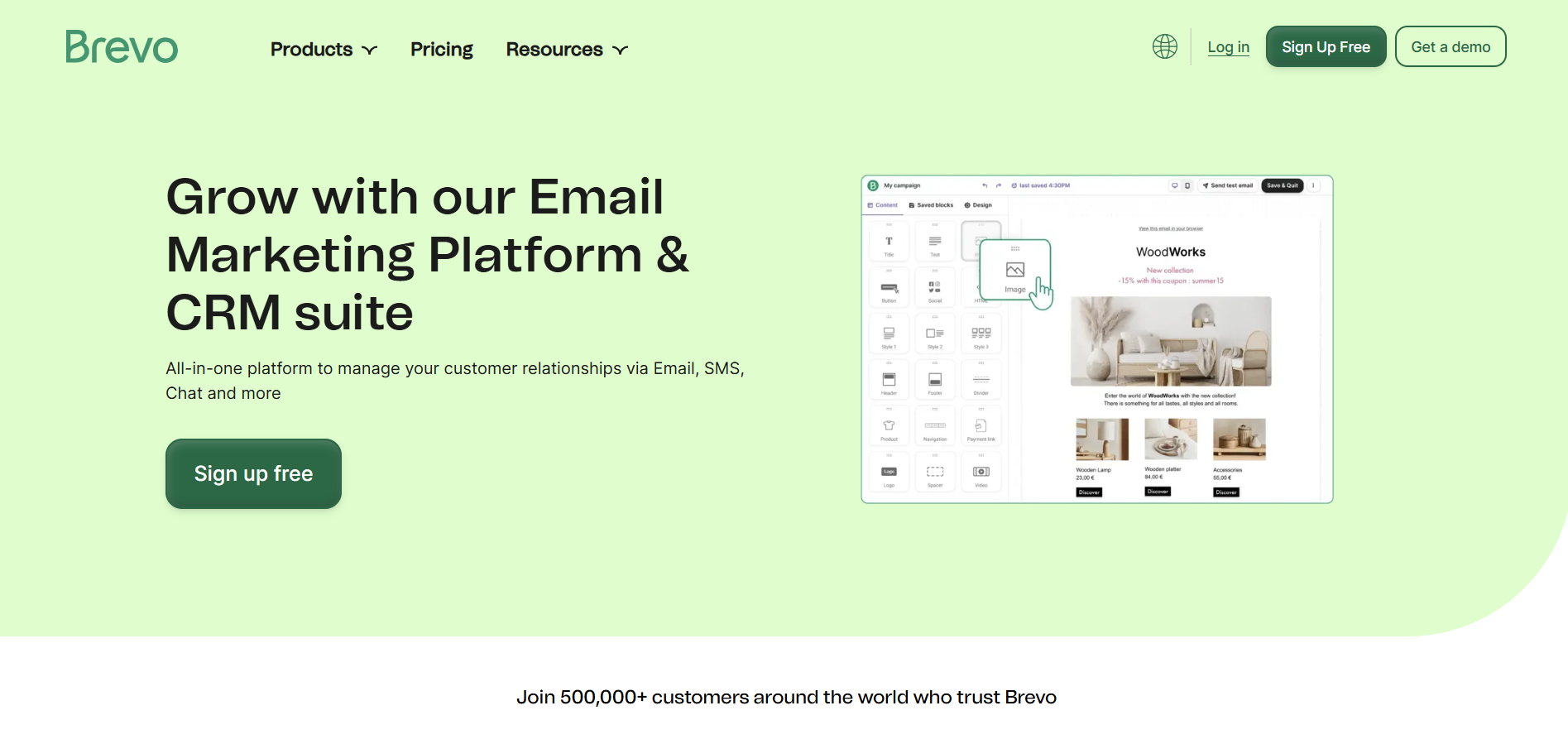
Sendinblue is increasingly popular for businesses wanting multi-channel engagement (email, SMS, chat) in a single platform. It also stands out for using a pay-by-email-sent model, which can be more budget-friendly if you have a large list unlimited contacts but send fewer messages each month.
Sendinblue vs Constant Contact
Multi-Channel Marketing: Instead of paying for separate SMS or chat services, you can integrate them natively with your email marketing under Sendinblue’s umbrella.
Volume-Based Pricing: Great if your subscriber list is huge, but your send frequency is moderate, possibly costing less than a contact-based plan.
Key Features of Sendinblue
Drag-and-Drop Editor: Craft appealing email templates that render well on mobile devices.
Transactional Email: Manage transactional messages—order confirmations, account creations, etc.—so all communications carry consistent branding.
Marketing Automation: Create custom workflows for re-engaging lapsed subscribers or rewarding highly active customers.
Real-Time Reporting: Visual dashboards reveal open/click rates, unsubscribes, and advanced metrics like conversions if you integrate with your website analytics.
Sendinblue Pros
Generous Free Plan: Send up to 300 emails daily, unlimited subscriber storage. Perfect for small shops or content creators who email sporadically.
Unified Contact Database: Tag, segment, and manage contacts across multiple channels in one interface.
Multiple User Roles: Team members can share the same account with varying permission levels, useful for mid-sized or larger organizations.
Sendinblue Cons
Template Customization: Although functional, the design library and editing capabilities are not as extensive or advanced as some other platforms.
Automation Complexity: Might lack the extremely advanced conditionals found in ActiveCampaign or Klaviyo for e-commerce.
Support Variability: Free users might experience slower or email-only support, which can hinder urgent problem resolution.
Sendinblue Pricing
Sendinblue’s free plan focuses on limiting daily sends to unlimited emails. For bigger sends, monthly packages start at a competitive rate, and you can also choose pay-as-you-go credits. Additional features, like advanced automation or multi-user collaboration, may require stepping up to higher tiers.
5. ActiveCampaign
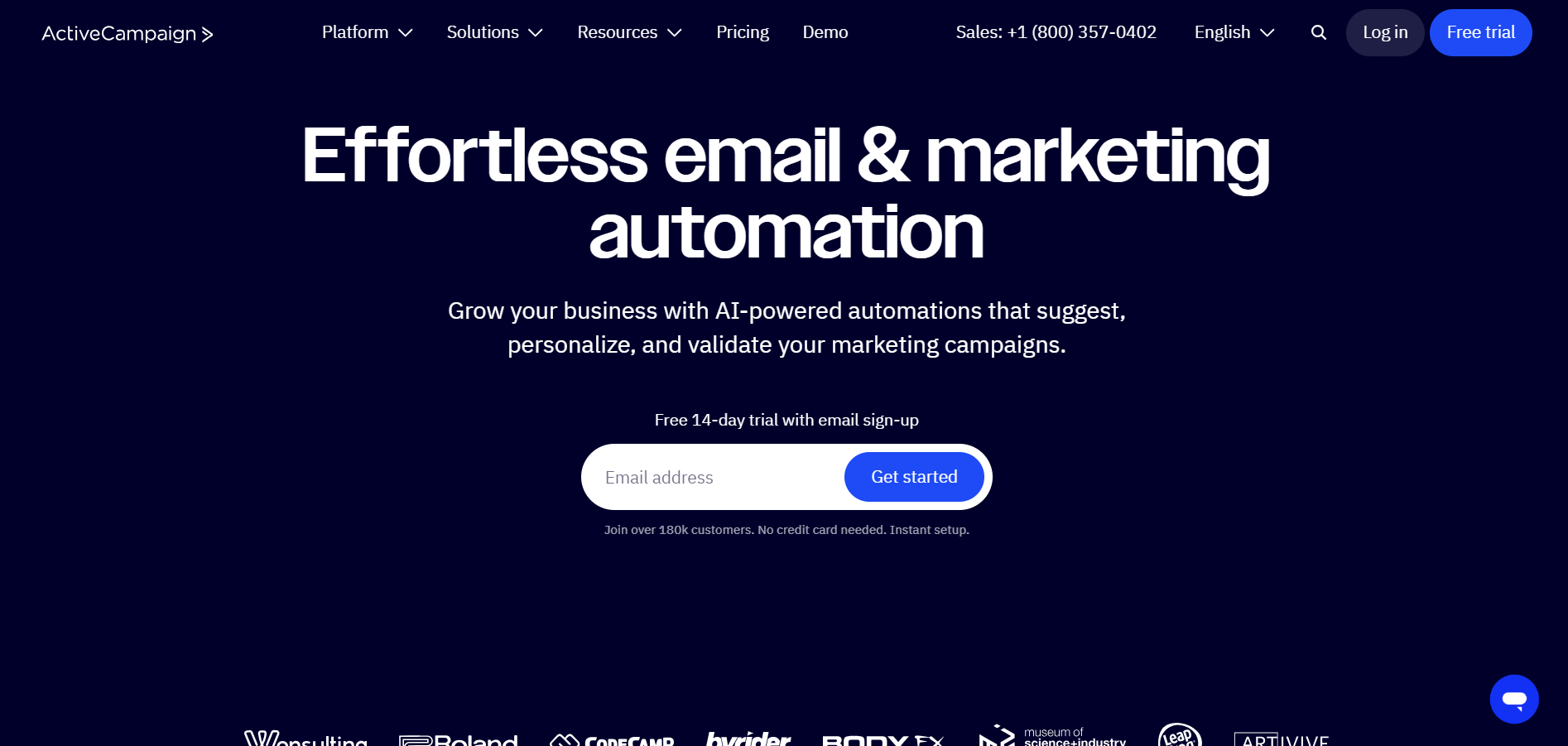
ActiveCampaign has become a heavyweight in marketing automation, known for its dynamic automation workflows, built-in CRM, and user-friendly yet powerful automation builder. This platform is especially apt for companies that have a well-defined funnel or rely on highly personalized communications throughout the customer journey.
ActiveCampaign vs Constant Contact
CRM Synergy: ActiveCampaign’s integrated CRM means you can manage your sales pipeline directly from your email marketing platform, bridging the gap between marketing and sales teams.
Extensive Conditional Workflows: If you need multi-step logic (e.g., “If user opened email A and visited webpage B but did not purchase, then send email C”), ActiveCampaign stands out.
Key Features of ActiveCampaign
Visual Automation Builder: Drag nodes for triggers, conditions, and actions to create branching workflows.
Lead Scoring and Tagging: Score leads based on behaviors like link clicks, form submissions, or site visits to focus your outreach on the most engaged prospects.
Predictive Sending: ActiveCampaign’s machine learning can attempt to determine the best times to send each campaign segment.
Multi-Channel Outreach: Include SMS, site messaging, and direct lead management in the same environment.
ActiveCampaign Pros
High-Level Automation: Great for organizations that handle complex sales cycles or provide multiple touchpoints over time.
Robust Analytics: Evaluate which automations yield the best ROI, track contact lifecycles, and refine your approach.
Flexible Integrations: Ties into e-commerce platforms, CRMs like Salesforce, or even membership sites.
ActiveCampaign Cons
Learning Curve: Marketers unaccustomed to advanced sequences or CRM usage can be overwhelmed initially.
Pricing Increases with Features: Basic plans include standard automation, but specialized features like lead scoring or site messaging are in higher tiers.
Setup Time: Building out elaborate workflows requires planning and consistent testing to ensure no logic flaws exist.
ActiveCampaign Pricing
ActiveCampaign’s pricing depends on the contact count plus your plan tier (Lite, Plus, Professional, or Enterprise). Each level unlocks advanced marketing options, from CRM tools to deeper personalization. They do offer a limited trial period to explore the interface before fully committing.
6. Klaviyo
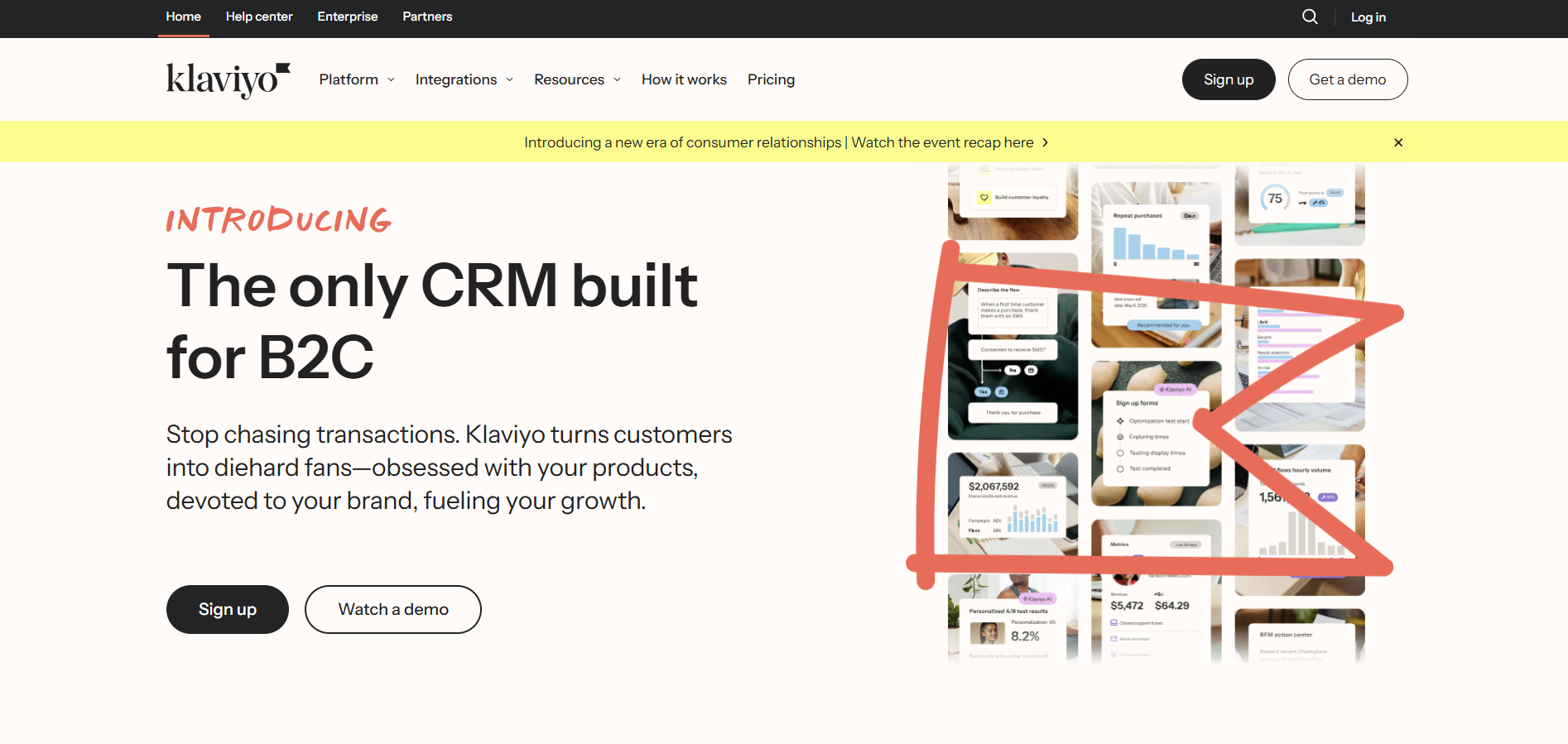
Klaviyo is a specialized platform with a laser focus on e-commerce marketing. It seamlessly integrates with online stores to gather real-time data, then harnesses that data for highly personalized campaigns and product recommendations.
Klaviyo vs Constant Contact
E-commerce Emphasis: While Constant Contact can do basic e-commerce integration, Klaviyo’s entire platform revolves around store-specific triggers and advanced segmentation.
ROI Tracking: Klaviyo commonly displays how much revenue each email generated, helping e-commerce managers gauge campaign profitability instantly.
Key Features of Klaviyo
E-commerce Data Sync: Tightly connects with Shopify, WooCommerce, Magento, and more to import purchase data, product details, and site behaviors.
Predictive Analytics: Forecasts the likelihood of future purchases, potential lifetime value, and churn risk.
Sophisticated Segments: Build dynamic groups based on purchase frequency, average order value, or product category interest.
Abandoned Cart and Post-Purchase Sequences: Automate reminders for incomplete checkouts or follow-up after certain purchases with recommended items, how-to guides, or cross-sell offers.
Klaviyo Pros
Superior Personalization: Place dynamic product feeds or user-specific coupon codes in your campaigns to drive conversions.
Comprehensive Metrics: See real-time revenue updates, track order trends, and monitor performance across each campaign or flow.
Scalable with Growth: As your store gains new SKUs or markets, you can fine-tune automations to maintain relevant communications for each audience subset.
Klaviyo Cons
Pricing Grows with Store Size: If your subscriber list or monthly email volume grows quickly, costs can rise sharply.
Niche Focus: Non-e-commerce users miss out on the specialized features that drive Klaviyo’s brand recognition.
Requires More Technical Setup: Implementing advanced flows might need some coding or technical knowledge, especially if you want to design custom email blocks or deeper segmentation rules.
Klaviyo Pricing
Klaviyo’s free plan supports up to 250 contacts and 500 monthly sends, providing a test bed for smaller e-commerce stores. Beyond the free version of that, you pay based on contact volume, with additional capabilities such as email and SMS combos scaling up.
Conclusion
When selecting an email marketing solution, it’s pivotal to align the platform’s capabilities with your marketing strategy, budget, and growth stage. Constant Contact remains a solid choice for straightforward newsletters or direct mail campaigns, but if you’re in search of advanced automation features, nuanced segmentation, or specialized e-commerce features, these six alternatives—Mailchimp, AWeber, GetResponse, Sendinblue, ActiveCampaign, and Klaviyo—provide a wide spectrum of options.
For Simplicity and Low Budget: AWeber offers a user-friendly environment, while Mailchimp’s free plan or Sendinblue’s pay-by-volume structure can keep costs manageable.
For Robust Marketing Suites: GetResponse or ActiveCampaign deliver wide-ranging functionality, from funnel creation to advanced CRM features, letting you coordinate diverse campaigns.
For E-Commerce: Klaviyo’s deep store integration and real-time revenue tracking can supercharge sales funnel optimization.
By weighing factors like automation level, template variety, analytics depth, multi-channel expansions, and e-commerce integration, you can pinpoint the email marketing tool that dovetails best with your unique objectives. The alternatives highlighted here empower businesses with everything from automated workflows to simple, cost-effective broadcasting to enterprise-grade data intelligence—ensuring your email strategy remains dynamic, effective, and poised for growth.
FAQs on Constant Contact Alternatives
1. What are the top alternatives to Constant Contact?
The six best-known and widely adopted alternatives include Mailchimp, AWeber, GetResponse, Sendinblue, ActiveCampaign, and Klaviyo. Each solution excels in different areas:
Mailchimp: Ideal for beginners wanting a familiar interface, with robust free tiers for smaller lists.
AWeber: Simpler, focusing on deliverability and straightforward broadcast/email series.
GetResponse: Comprehensive, thanks to landing pages, webinars, and a built-in CRM.
Sendinblue: Multi-channel marketing that covers email, SMS, and chat, plus flexible pay-by-email pricing.
ActiveCampaign: Advanced marketing automation and CRM integration for more nuanced funnels.
Klaviyo: E-commerce-centric platform delivering deep personalization and advanced tracking for online retailers.
2. Why should I consider using an alternative to Constant Contact?
You might switch for multiple reasons, such as:
More Advanced Automation: If you need complex triggers, behavioral segmentation, or conditional workflows that adapt to user actions.
Multi-Channel Outreach: Tools like Sendinblue merge email, SMS, and chat in one place, facilitating cross-channel engagement.
E-Commerce Specialization: Klaviyo or ActiveCampaign align closely with online retail data, making them indispensable for revenue-driven marketing.
Adaptable Pricing Models: Some alternatives offer free tiers or let you pay by email volume, which could be more cost-effective depending on your contact list and send frequency.
3. Are these alternatives suitable for small businesses?
Yes. Many of these platforms specifically cater to small operations, offering:
Low-Cost or Free Plans: Mailchimp, Sendinblue, and even AWeber have entry-level tiers or free trials.
Simple Editors: Most come with drag-and-drop email builders that don’t require design or coding know-how.
Automations That Scale: Even small businesses benefit from basic workflows—like welcome emails or simple drip series—that can get more sophisticated if the business grows.
4. Which alternative is best for e-commerce businesses?
Klaviyo stands out as a powerhouse for online retail, seamlessly integrating with store platforms and providing real-time revenue and purchase data. This data can be leveraged for advanced personalization—such as recommending products based on a user’s browse history, or sending special re-engagement offers to big spenders. ActiveCampaign is another strong contender, especially if you need advanced CRM elements or want to unify email marketing with robust site tracking.